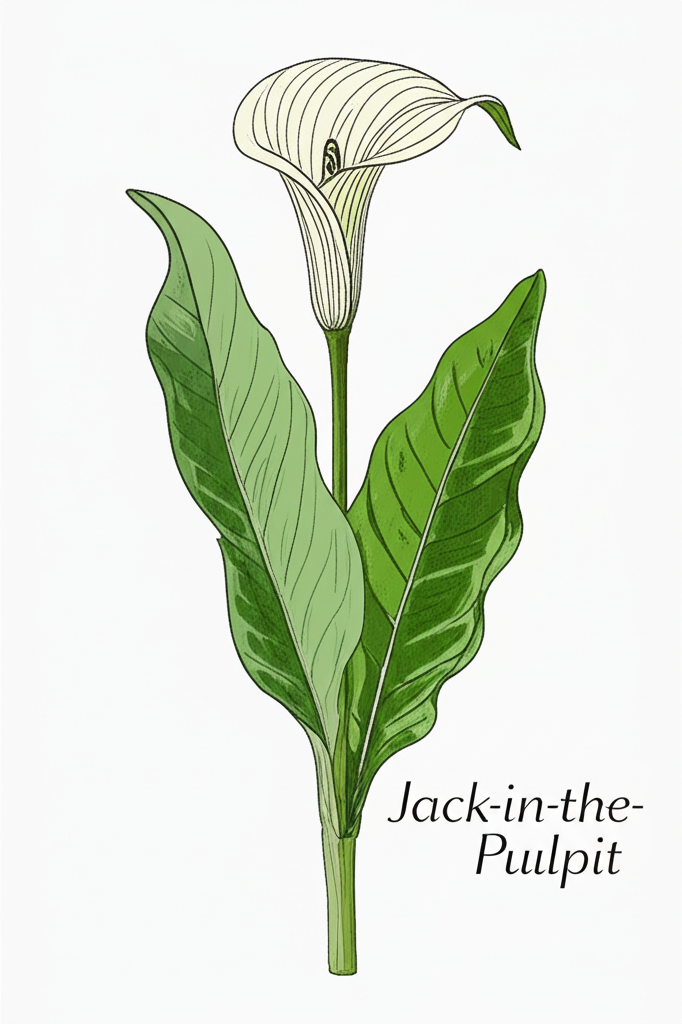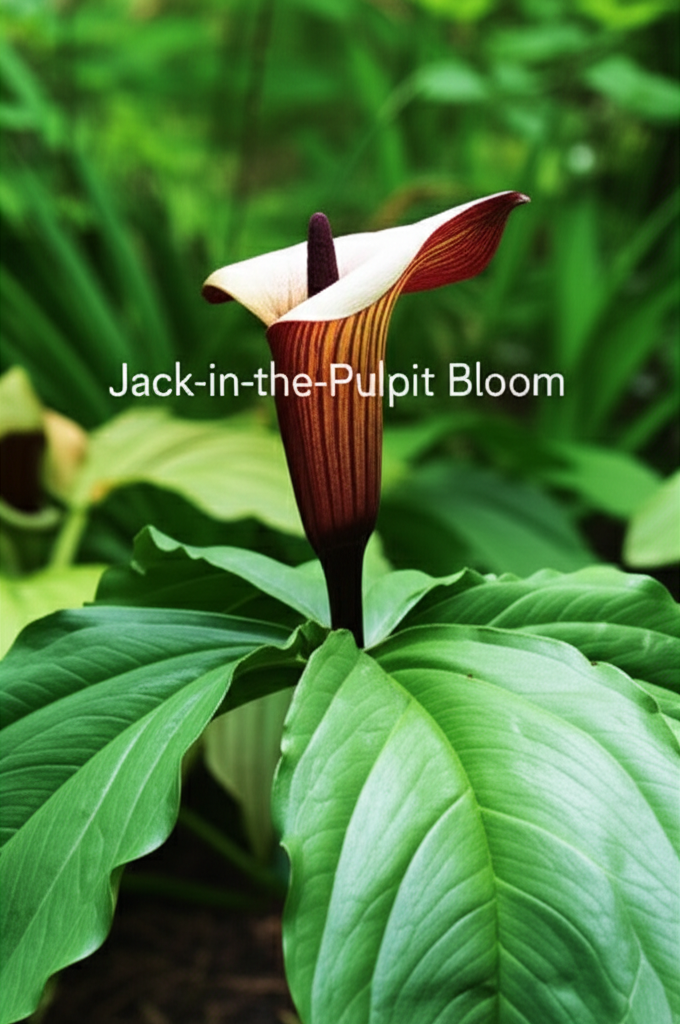Introduction to the Fascinating Jack-in-the-Pulpit
The Jack-in-the-Pulpit, scientifically known as Arisaema triphyllum, is a captivating woodland wildflower that has long held a special place in the hearts of naturalists and artists alike. Its unique and intriguing morphology, coupled with its ecological significance, makes it an exceptionally rewarding subject for botanical illustration. This article delves into the botanical intricacies of the Jack-in-the-Pulpit, exploring its fascinating life cycle, distinctive features, and the creative opportunities it presents for aspiring and seasoned botanical artists. We will examine its habitat, reproductive strategies, and seasonal changes, providing a comprehensive understanding for anyone looking to capture its essence on paper or digitally.
Botanical Classification and Characteristics

The Jack-in-the-Pulpit belongs to the Araceae family, which also includes familiar plants like calla lilies and philodendrons. This kinship is evident in its characteristic spadix and spathe, the flower-like structures that give the plant its common name.
Key Identifying Features
- The “Pulpit” (Spathe): This is the large, hood-like leaf that encloses the reproductive parts. It is typically green with prominent purplish-brown veins, though color variations exist. The spathe is often curved, creating the illusion of a pulpit.
- The “Jack” (Spadix): Emerging from the base of the spathe, the spadix is a fleshy spike bearing tiny, unisexual flowers. It often has a club-like tip, which can be significantly longer than the spathe, giving rise to the “Jack” in the pulpit.
- Leaves: The plant usually possesses two basal leaves, each typically divided into three leaflets. These trifoliate leaves are a defining characteristic and are arranged on long, sturdy petioles.
- Stems (Petiole): The flowering stalk, or peduncle, which supports the spathe and spadix, arises directly from the underground corm, not from the leaves. This is an important distinction for accurate botanical representation.
Underground Structure: The Corm
Beneath the surface, the Jack-in-the-Pulpit has a tuberous rootstock known as a corm. This corm is crucial for the plant’s survival and reproduction, storing nutrients and allowing it to respawn year after year. The corm also plays a role in sex determination, with larger, older corms tending to produce more flowers and often developing into female plants.
Life Cycle and Seasonal Changes: A Chronological Study
Understanding the dynamic life cycle of the Jack-in-the-Pulpit is essential for capturing its essence at different stages. Its transformations throughout the year offer a wealth of inspiration.
Spring Emergence
As the forest floor awakens in spring, the Jack-in-the-Pulpit begins its dramatic emergence. The tightly furled spathe and spadix push through the leaf litter, often exhibiting a gradient of green and purple hues. Initially, the plant may appear as a single stem with a developing spathe.
Flowering and Pollination
The true “flowering” occurs within the spathe, where numerous small flowers adorn the spadix. The plant employs a clever strategy to attract and trap its pollinators, primarily small flies and gnats. Scent glands and sticky surfaces within the spathe create a moist, alluring environment. Tiny hairs pointing downwards prevent insects from escaping until pollination has occurred.
Fruiting: The Striking Berry Cluster
Following successful pollination, the spathe begins to wither, and the spadix becomes less prominent. The plant then develops a cluster of bright red, fleshy berries. This transition is a significant visual change, offering a striking contrast to the earlier green and purple tones. The berries are a vital food source for various woodland birds, which then disperse the seeds.
Autumn and Dormancy
As autumn approaches, the leaves of the Jack-in-the-Pulpit begin to yellow and decay, returning nutrients to the soil. The corm enters a period of dormancy, preparing for the following spring’s resurgence. The remnants of the fruiting stalk may persist for some time, a testament to the plant’s reproductive success.
Habitat and Ecological Niche
The Jack-in-the-Pulpit thrives in specific ecological conditions, which are crucial for its survival and influence its appearance. Illustrators can gain valuable insights by understanding its preferred environment.
Woodland Settings
This plant is a quintessential inhabitant of moist, shaded woodlands. It prefers deciduous forests where it receives dappled sunlight filtering through the canopy. The rich, humus-laden soil of these environments provides the necessary nutrients.
Moisture Requirements
Consistent moisture is vital for the Jack-in-the-Pulpit. It is often found near streams, in low-lying areas, or on north-facing slopes where the soil retains moisture. Drought conditions can severely impact its growth and survival.
Associated Flora
Observing the plants that grow alongside the Jack-in-the-Pulpit can add context and realism to illustrations. Common companions include ferns, mosses, trilliums, wild ginger, and various woodland sedges. Capturing these elements can create a more immersive and informative botanical study.
Jack-in-the-Pulpit: A Botanical Illustrator’s Guide
The unique structure and seasonal evolution of the Jack-in-the-Pulpit offer a wealth of opportunities for botanical artists. Every aspect of this plant, from its intricate floral structure to its changing colors, provides a compelling subject for detailed study and artistic interpretation.
Key Aspects for Illustration
- Form and Structure: The distinct spathe and spadix present a fascinating challenge. Accurately depicting the curvature of the spathe, the texture of its veins, and the precise form of the spadix is paramount. The trifoliate leaves also require careful attention to venation and leaflet shape.
- Color Palette: The Jack-in-the-Pulpit boasts a rich and varied color palette throughout its life cycle. From the vibrant greens and deep purples of the spathe to the striking crimson of the berries, artists can explore a wide range of hues. The subtle variations in veining and the subtle mottling of the spathe add further complexity.
- Texture: The spathe has a smooth, somewhat waxy texture, while the spadix is fleshy. The berries are smooth and succulent. Capturing these textural differences through line work, shading, and color application is key to a realistic depiction.
- Light and Shadow: The way light filters through the woodland canopy dramatically affects the appearance of the Jack-in-the-Pulpit. Illustrators can play with light and shadow to emphasize its form and create a sense of atmosphere. The translucency of the spathe in certain light conditions can also be a captivating element.
- Seasonal Progression: Documenting the Jack-in-the-Pulpit through its annual cycle provides a narrative element to an illustration series. This can showcase its emergence, flowering, fruiting, and eventual decline, offering a comprehensive understanding of its life.
Challenges and Rewards of Illustrating Arisaema triphyllum
While the Jack-in-the-Pulpit is an artistically rewarding subject, it also presents certain challenges that can push an illustrator’s skills.
Challenges
- Capturing the “Pulpit” Illusion: Accurately rendering the deceptive nature of the spathe, creating the sense of depth and enclosure, requires careful observation and skillful application of perspective and shading.
- Depicting the Spadix: The spadix, often hidden within the spathe, can be difficult to observe and draw accurately, especially its internal structure and the placement of the flowers.
- Color Nuances: The subtle shifts in color within the spathe, the gradations from green to purple, and the intricate veining can be challenging to replicate precisely.
- Botanical Accuracy: Ensuring that all botanical elements – the number of leaflets, the arrangement of the flowers, the structure of the corm – are accurately represented requires diligent research and close examination.
Rewards
- Unique Subject Matter: The Jack-in-the-Pulpit is far from a commonplace wildflower. Its unusual form guarantees a distinctive and memorable illustration.
- Educational Value: A well-executed botanical illustration of this plant can serve as an educational tool, teaching viewers about its anatomy, life cycle, and ecological role.
- Artistic Exploration: The plant offers endless opportunities for stylistic exploration, from hyperrealism to more stylized interpretations, allowing artists to develop their unique voice.
- Connection to Nature:** The process of observing and illustrating the Jack-in-the-Pulpit fosters a deeper connection with the natural world and its intricate wonders.
Comparison: Jack-in-the-Pulpit vs. Other Araceae Family Members
While sharing the characteristic spathe and spadix, the Jack-in-the-Pulpit has distinct features that set it apart from other members of the Araceae family. Understanding these differences can inform an artist’s interpretation.
| Feature | Jack-in-the-Pulpit (Arisaema triphyllum) | Calla Lily (Zantedeschia aethiopica) | Peace Lily (Spathiphyllum spp.) |
|---|---|---|---|
| Native Habitat | Moist, shaded woodlands of eastern North America | Southern Africa; often cultivated | Tropical rainforests of the Americas and Asia; often cultivated |
| Leaf Shape | Trifoliate (three leaflets) | Arrowhead-shaped, basal | Lanceolate to ovate, dark green |
| Spathe Color | Green with purplish-brown veins; variable | White or creamy white; rarely colored | White; often prominent |
| Spadix | Fleshy, often club-shaped, with prominent apical appendage | Yellowish, dense cylinder | Creamy white to yellowish, less dense than Calla Lily |
| Fruiting Body | Bright red berries in a cluster | Not typically showy in cultivation; produces seed pods | Not typically showy in cultivation; produces small berries |
| Overall Habit | Herbaceous perennial emerging from a corm | Herbaceous perennial emerging from a rhizome | Herbaceous perennial, often epiphytic or terrestrial |
Steps to Illustrating Jack-in-the-Pulpit
A systematic approach can help botanical illustrators create accurate and compelling depictions of the Jack-in-the-Pulpit.
| Step | Description | Tips for Success |
|---|---|---|
| 1. Observation and Reference Gathering | Study living specimens, high-quality photographs, and botanical illustrations. Document its habitat and associated flora. | Observe multiple specimens at different life stages. Note color variations, vein patterns, and any signs of insect damage or disease. |
| 2. Basic Sketch and Composition | Begin with light, gestural sketches to capture the overall form and proportions. Decide on the most compelling angle and composition. | Focus on the relationship between the spathe, spadix, and leaves. Consider including elements of its habitat for context. |
| 3. Detailed Line Drawing | Refine the sketch into a precise line drawing, paying close attention to botanical accuracy, including venation and structural details. | Use a light touch. Ensure symmetry where appropriate and introduce subtle asymmetry to reflect natural forms. Use a fine-tipped pen or pencil. |
| 4. Color Study and Application | Mix colors carefully, observing the subtle transitions and variations. Apply color in thin layers, building up depth and luminosity. | Start with the dominant colors and gradually introduce subtle hues and undertones. Use glazes to achieve smooth transitions. |
| 5. Shading and Texture | Use tonal values to create form and volume. Employ different mark-making techniques to represent the various textures of the spathe, spadix, and leaves. | Observe how light falls on the plant. Use stippling, cross-hatching, or washes to depict the smooth spathe, fleshy spadix, and veined leaves. |
| 6. Final Refinements and Details | Add final highlights, subtle details, and any necessary adjustments to ensure accuracy and visual impact. | Look for opportunities to enhance the illustration with details like dew drops, small insects, or soil particles. Review against your reference material. |
Conclusion: A Timeless Subject for Botanical Art
The Jack-in-the-Pulpit, with its compelling architecture, intriguing life cycle, and subtle ecological connections, offers an inexhaustible source of inspiration for botanical illustrators. Its enigmatic presence in shaded woodlands invites detailed observation and artistic interpretation. By understanding its botanical intricacies, life cycle, and preferred habitat, artists can create illustrations that are not only visually stunning but also scientifically accurate and deeply evocative. Whether capturing the vibrant red berries of autumn or the nascent unfurling of spring, the Jack-in-the-Pulpit remains a timeless and rewarding subject for those dedicated to the art and science of botanical illustration. Its unique form and seasonal transformations ensure that it will continue to captivate and challenge artists for generations to come.


